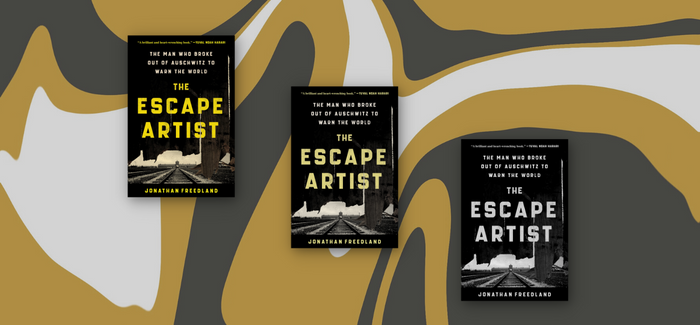Books
Non-fiction
The True Story of the Auschwitz ‘Escape Artist’
The Escape Artist: The Man Who Broke Out of Auschwitz to Warn the World
By Jonathan Freedland (Harper)
Walter Rosenberg was 18 years old when he was taken from a small town in what was then Czechoslovakia and sent to Auschwitz. The roughly two years he spent in the infamous concentration camp makes up the first half of British journalist Jonathan Freedland’s detailed, well-researched and moving book, The Escape Artist.
But very little in those pages prepares you for what follows: Rosenberg escapes from the camp and attempts to tell the world the truth about the Nazi atrocities that he witnessed—and his account is largely ignored.
The Auschwitz portion of the book is, perhaps, less emotionally charged than one might expect because it is sadly familiar, akin to accounts such as Elie Wiesel’s harrowing Night as well as memoirs from other survivors.
But Rosenberg’s story isn’t only about survival; it is also about resistance, a determination to escape if only to warn the Hungarian Jews—in early 1944, the last large group of European Jews facing deportation—what awaited them in the concentration camp. He had hoped this knowledge would make them resist Nazi deportations.
“It’s much easier to slaughter lambs than hunt deer,” Freedland quotes him as saying.
The Escape Artist recounts how, in April 1944, Rosenberg and fellow prisoner Alfred Wetzler became the first Jews to break out of Auschwitz and avoid recapture—two of only four inmates to pull off that feat. For three days, they hid under a pile of wood near the edge of the camp that they had laced with gasoline-soaked tobacco to throw guard dogs off their scent. After escaping, Rosenberg took the name Rudolf Vrba. He and Wetzler ultimately wended their way to Czechoslovakia and were put in contact there with the Jewish council.
Their account of the camp and the Nazi campaign to exterminate the Jews, a 32-page document called the Vrba-Wetzler report, was distributed to contacts in Europe in the hope of influencing still-free governments to thwart the Nazi’s plan for the Jews.
The report had some immediate impact. Major stories were carried by Swiss newspapers, and those items were eventually picked up by outlets in London and New York City. Their account also gave Hungarian Regent Admiral Miklos Horthy an excuse to halt deportations from his country, saving, at least temporarily, 200,000 Jews. However, the Black Arrow, the country’s Nazi party, soon took over and resumed the deportations. A Jewish resistance in Hungary never materialized.
In the United States, the Office of War Information refused to publish the report, arguing that no one would believe it. The Army newspaper Yank likewise refused because the report was deemed “too Semitic.” Meanwhile, the American military would do nothing that might require a “diversion from the war effort,” notes Freedland, explaining that such rationale fit with the Allies’ logic that the best way to stop the genocide was to defeat the Nazis.
At the same time, America would not raise its quotas to allow more Jewish refugees to enter the country, and notoriously antisemitic embassy and consulate officials were slow to issue the visas that were available.
Exploring the whys and hows of the failure to aide Europe’s Jews is what makes The Escape Artist the most important book about the Allies’ inaction to save Jewish lives since Martin Gilbert’s 2001 Auschwitz and the Allies.
Freedland first heard of Rosenberg/Vrba when he was 19 and watched Claude Lanzmann’s seminal Holocaust documentary, Shoah.
“I left the cinema that night convinced that the name of Rudolf Vrba deserved to stand alongside Anne Frank, Oskar Schindler and Primo Levi in the first rank of stories that define the Shoah,” Freedland writes. “That day may never come. But maybe, through this book, [he] might perform one last act of escape: Perhaps he might escape our forgetfulness and be remembered.”
Curt Schleier, a freelance writer, teaches business writing to corporate executives.










 Facebook
Facebook Instagram
Instagram Twitter
Twitter
Arkay Garber says
I reside in Jerusalem and teach the craft of screenwriting techniques for novel, film, and stage play. My website is: arkaygarber.com. As I read Curt Schleier’s review of The Escape Artist: The Man Who Broke out of Auschwitz to warn the world, I instantly thought about how this story could become a movie. A few quick points on crafting this story: 1. The Memoir/True Story technique needs to be employed to create conflict from page 1. As Curt mentions, the graphic description of Auschwitz prison/crematoria has been done before. It needs to be encapsulated as part of the larger story: The complete destruction of Jewish culture and humanity while the world stood still. The silence was deafening. The excuses were horrific. But despite all of that, the hero of the story escaped and did the impossible: Confronted an uncaring/Jew-hating world with the truth. He changed some souls and moved them to action. His journey should be the main focus of the story, from p. 1. He should be crafted as a mythological hero, despite the fact that he sought no notoriety. His story of survival and escape and the epic story of the uncaring world, similar to a dystopian world are what would make this a great film.
RENEE LEASE says
tears came to myeyes reading the story of this wonderful man. there are many stories still to come of these wonderful brave people will sstill be coming in the near future. thank you for this information. there are so many stories of bravery at that time, that it is impossible to find them all. thank you so much for what you have done to bring this story out. RENEE LEASE